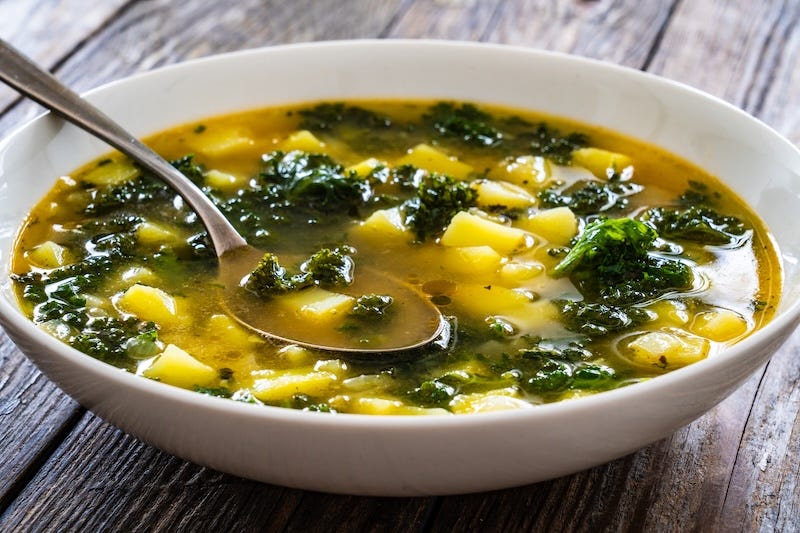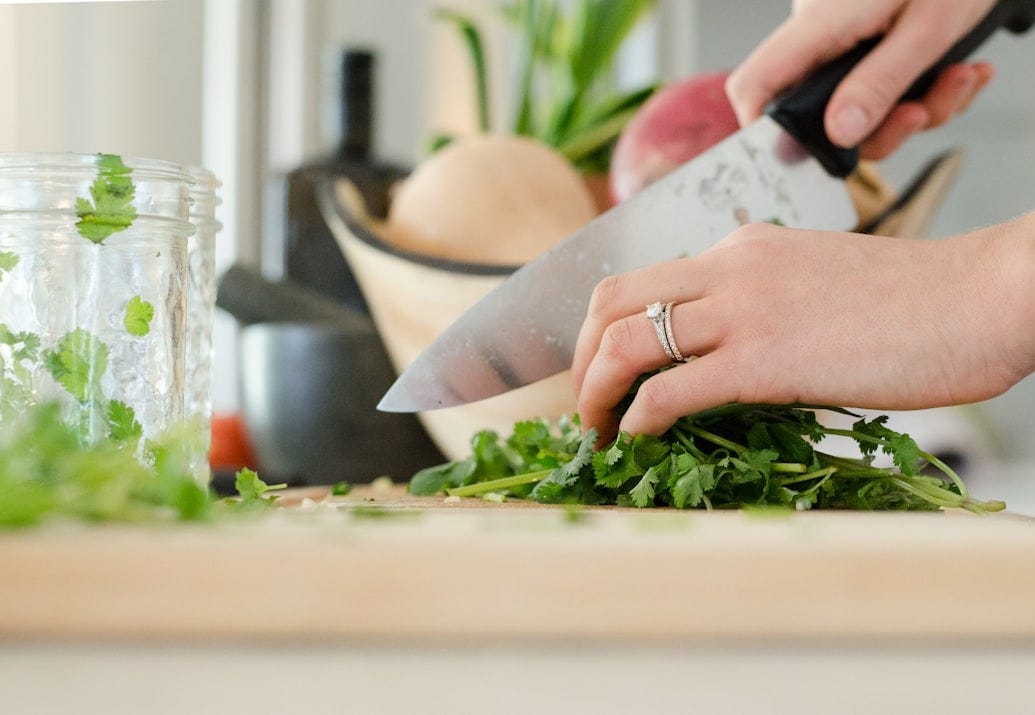Homemade Vegetable Stock
Use those vegetable scraps to prevent food waste, save money, avoid packaging, and make a delicious base for any soup, stew, or risotto!
Making your own vegetable stock is simple, cost-effective, and a great way to reduce food waste. You can use fresh vegetables or scraps collected over time. Below are methods for both the Pressure Cooker (Instant Pot) and Stovetop, along with key tips on what to include (or avoid) for the best flavor.
Gathering and Preparing Your Vegetables
I keep a bowl on the counter for vegetable scraps as I cook, adding onion skins, carrot peels, celery leaves, and other bits and ends. If I know I’ll be making stock within a day or two, I leave the bowl out with a towel covering it, but if it’ll be longer, I store the scraps in a covered container in the fridge or freezer.
The flavor of your vegetable stock will vary each time, depending on the mix of veggie scraps, herbs, and seasonings you use. While this variation is part of the beauty of homemade stock, you can still create delicious consistency by keeping a few key guidelines in mind.
What to Use (or Avoid Altogether)
By being mindful of your ingredient choices, you can ensure a rich, flavorful, and versatile stock every time.
Aromatic staples – scallions, shallots, onions (skins on for a darker broth, off for a lighter one), carrots (carrot peels), and celery form a solid flavor base.
Flavor boosters – leeks, garlic, mushroom stems, and parsley stems enhance depth and complexity.
Cruciferous vegetables (broccoli, cabbage, Brussels sprouts) – can make the stock bitter, so use in moderation. If I have a ton of kale stems, for instance, I’ll just split them up and use in two different batches of stock.
Potato peels – can make the broth starchy and cloudy.
Beets – will turn the stock red or deep purple.
Zucchini & summer squash – can create a slimy texture if overcooked.
As for enhancing the flavor even more:
Roast the vegetables at 400°F (200°C) for 25-30 minutes before simmering. (Coat them with some oil first.)
Add ¼ to ½ cup dried mushrooms (shiitake or porcini) for extra umami.
Add fresh herbs like rosemary, thyme, or parsley stems for a more herbaceous stock.
To keep it salt-free, season individual dishes as needed instead of salting the stock itself.
How to Make Vegetable Stock
Once you’ve gathered your vegetable scraps and seasonings, making stock is simple. Whether you use an Instant Pot for speed or a stovetop for a more traditional simmer, the process is straightforward and rewarding. The longer it cooks, the deeper the flavor—but even a quick batch can create a rich, versatile broth for soups, stews, and more.
Pressure Cooker Method
Add all ingredients to the Instant Pot.
Pour in water (do not exceed the max fill line).
Add 2 bay leaves, 6–8 whole peppercorns, a few sprigs of thyme or parsley stems, and salt (optional, to taste).
Set to high pressure for 20-30 minutes.
Allow natural pressure release (takes about 15 minutes).
Strain. I usually strain into a large bowl, and let it cool there, before transferring to containers.
Stovetop Method
Add all ingredients to a large stockpot.
Add 2 bay leaves, 6–8 whole peppercorns, a few sprigs of thyme or parsley stems, and salt (optional, to taste).
Cover with water and bring to a boil.
Reduce to a gentle simmer and cook for 60 minutes.
Strain. I usually strain into a large bowl, and let it cool there, before transferring to containers.
Storing Your Stock
Once the stock is cool, I transfer it to glass jars of various sizes. This way, I can thaw just one jar at a time—or two if I need more—rather than dealing with one large frozen block of stock.
If freezing, be sure to leave at least an inch of space at the top of each jar to allow for expansion as the liquid freezes. This helps prevent the glass from cracking. Will keep in the freezer for 3 months, but USE it before then. That’s what it’s there for.
THAWING TIP: If you need to use your frozen stock right away and didn’t thaw it in advance, simply place the sealed jar in a bowl of hot water. Let it sit for a few minutes, replacing the water as it cools, until the stock loosens enough to pour out. This method is perfect for last-minute cooking and avoids the need for microwave defrosting!
For even more convenience, pour some of the stock into ice cube trays and freeze. Once solid, transfer the cubes to a sealed container or freezer bag. These small portions are perfect for adding a quick burst of flavor to sauces, grains, or sautés without defrosting a whole jar.
For short-term use, store the stock in the fridge—it will keep for up to a week and is ready to use whenever you need it. Use the stock anywhere you’d use vegetable broth—soups, stews, risottos, sauces, or even for cooking grains like rice and quinoa. It’s an easy, no-waste way to elevate your cooking.

What to Do with the Strained Vegetables
Once you’ve extracted all the flavor, the leftover vegetables will be soft and mushy. Since most of the nutrients have been drawn out, they’re best used in ways that don’t rely on flavor but still make use of their fiber and texture.
Compost them – Add them to your home compost or your city’s curbside compost pickup if available. This is the simplest, most eco-friendly way to return nutrients to the earth.
Bury them in the garden (trench composting) – Blend them up, dig a small hole in the back garden, and bury the scraps directly in the soil, allowing them to break down naturally. Bury them well to prevent critters. Rotate the location each season to avoid over-enriching one spot.
Blend them into a soup base – If there’s still some flavor left, blend the soft vegetables with a little fresh stock to thicken soups or stews.
Use them in homemade vegetable patties – Mix them into lentil or bean-based burger patties for extra bulk and fiber.
Make dog treats (if pet-safe) – Mash and mix with oats or whole wheat flour to make simple dog biscuits (avoid onion, garlic, and anything unsafe for dogs).
If none of these options work for you, composting is always the best way to ensure nothing goes to waste!
More tips like this in my upcoming book A Year of Compassion: 52 Weeks of Living Zero-Waste, Plant-Based, and Cruelty-Free.
Additional Resources
👉 Because the publisher took The Vegan Table (and Color Me Vegan) out of print, I am able to repurpose all of my recipes for which I own the copyright again. Please check out my Recipe E-Books and my library of On-Demand Cooking Classes for more tried and true recipes!
👉 Work with me 1:1 – Get personalized guidance to build healthier habits, cultivate self-compassion, communicate with conviction, strengthen emotional resilience, or whatever you are looking for.
👉 Read A Year of Compassion – Daily inspiration to help you live with intention, kindness, and compassion for humankind, animalkind, and the ecosystems we all depend on.
👉 Listen to Food for Thought – Inspiration for living compassionately, sustainably, and healthfully (18 years strong!)
👉 Travel with me! I host animal-friendly, luxury, all-inclusive vegan trips around the world, specifically curated to ensure high-quality, high-touch premium experiences. Check out our upcoming trips, and let me know if you have any questions.






